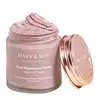What's inside
What's inside
 Key Ingredients
Key Ingredients

No key ingredients
 Benefits
Benefits

 Concerns
Concerns

 Ingredients Side-by-side
Ingredients Side-by-side

Water
Skin ConditioningGlycerin
HumectantOryza Sativa Bran Water
MaskingCaprylic/Capric Triglyceride
MaskingOryza Sativa Powder
Glycol Distearate
EmollientCetearyl Alcohol
EmollientAcrylates Copolymer
Oryza Sativa Extract
AbsorbentCI 77891
Cosmetic ColorantHydroxypropyl Methylcellulose
Emulsion Stabilising1,2-Hexanediol
Skin ConditioningEthylhexylglycerin
Skin ConditioningSodium Hydroxide
BufferingParfum
MaskingCetearyl Glucoside
EmulsifyingCarbomer
Emulsion StabilisingTriethoxycaprylylsilane
Aluminum Hydroxide
EmollientSodium Polyacrylate
AbsorbentButylene Glycol
HumectantGlucose
HumectantAspergillus Ferment
Skin ConditioningButylphenyl Methylpropional
PerfumingLinalool
PerfumingHydroxycitronellal
PerfumingWater, Glycerin, Oryza Sativa Bran Water, Caprylic/Capric Triglyceride, Oryza Sativa Powder, Glycol Distearate, Cetearyl Alcohol, Acrylates Copolymer, Oryza Sativa Extract, CI 77891, Hydroxypropyl Methylcellulose, 1,2-Hexanediol, Ethylhexylglycerin, Sodium Hydroxide, Parfum, Cetearyl Glucoside, Carbomer, Triethoxycaprylylsilane, Aluminum Hydroxide, Sodium Polyacrylate, Butylene Glycol, Glucose, Aspergillus Ferment, Butylphenyl Methylpropional, Linalool, Hydroxycitronellal
Water
Skin ConditioningDiglycerin
HumectantGlycerin
HumectantKaolin
AbrasiveBentonite
AbsorbentPropanediol
SolventZea Mays Starch
Absorbent1,2-Hexanediol
Skin ConditioningRosa Damascena Flower Water
MaskingPanthenol
Skin ConditioningRosa Gallica Flower Powder
Skin ConditioningXanthan Gum
EmulsifyingAcrylamide/Sodium Acryloyldimethyltaurate Copolymer
Emulsion StabilisingPolyisobutene
Betaine
HumectantButylene Glycol
HumectantParfum
MaskingEthylhexylglycerin
Skin ConditioningDipropylene Glycol
HumectantCI 77491
Cosmetic ColorantDisodium EDTA
Caprylyl/Capryl Glucoside
CleansingSorbitan Oleate
EmulsifyingAllantoin
Skin ConditioningHydrogenated Lecithin
EmulsifyingCentella Asiatica Extract
CleansingFicus Carica Fruit Extract
HumectantCeramide NP
Skin ConditioningSodium Hyaluronate
HumectantTocopherol
AntioxidantHyaluronic Acid
HumectantSodium Hyaluronate Crosspolymer
HumectantHydroxypropyltrimonium Hyaluronate
Sodium Acetylated Hyaluronate
HumectantWater, Diglycerin, Glycerin, Kaolin, Bentonite, Propanediol, Zea Mays Starch, 1,2-Hexanediol, Rosa Damascena Flower Water, Panthenol, Rosa Gallica Flower Powder, Xanthan Gum, Acrylamide/Sodium Acryloyldimethyltaurate Copolymer, Polyisobutene, Betaine, Butylene Glycol, Parfum, Ethylhexylglycerin, Dipropylene Glycol, CI 77491, Disodium EDTA, Caprylyl/Capryl Glucoside, Sorbitan Oleate, Allantoin, Hydrogenated Lecithin, Centella Asiatica Extract, Ficus Carica Fruit Extract, Ceramide NP, Sodium Hyaluronate, Tocopherol, Hyaluronic Acid, Sodium Hyaluronate Crosspolymer, Hydroxypropyltrimonium Hyaluronate, Sodium Acetylated Hyaluronate
 Reviews
Reviews

Ingredients Explained
These ingredients are found in both products.
Ingredients higher up in an ingredient list are typically present in a larger amount.
1,2-Hexanediol is a synthetic liquid and another multi-functional powerhouse.
It is a:
- Humectant, drawing moisture into the skin
- Emollient, helping to soften skin
- Solvent, dispersing and stabilizing formulas
- Preservative booster, enhancing the antimicrobial activity of other preservatives
Butylene Glycol (or BG) is used within cosmetic products for a few different reasons:
Overall, Butylene Glycol is a safe and well-rounded ingredient that works well with other ingredients.
Though this ingredient works well with most skin types, some people with sensitive skin may experience a reaction such as allergic rashes, closed comedones, or itchiness.
Learn more about Butylene GlycolEthylhexylglycerin (we can't pronounce this either) is commonly used as a preservative and skin softener. It is derived from glyceryl.
You might see Ethylhexylglycerin often paired with other preservatives such as phenoxyethanol. Ethylhexylglycerin has been found to increase the effectiveness of these other preservatives.
Glycerin is already naturally found in your skin. It helps moisturize and protect your skin.
A study from 2016 found glycerin to be more effective as a humectant than AHAs and hyaluronic acid.
As a humectant, it helps the skin stay hydrated by pulling moisture to your skin. The low molecular weight of glycerin allows it to pull moisture into the deeper layers of your skin.
Hydrated skin improves your skin barrier; Your skin barrier helps protect against irritants and bacteria.
Glycerin has also been found to have antimicrobial and antiviral properties. Due to these properties, glycerin is often used in wound and burn treatments.
In cosmetics, glycerin is usually derived from plants such as soybean or palm. However, it can also be sourced from animals, such as tallow or animal fat.
This ingredient is organic, colorless, odorless, and non-toxic.
Glycerin is the name for this ingredient in American English. British English uses Glycerol/Glycerine.
Learn more about GlycerinParfum is a catch-all term for an ingredient or more that is used to give a scent to products.
Also called "fragrance", this ingredient can be a blend of hundreds of chemicals or plant oils. This means every product with "fragrance" or "parfum" in the ingredients list is a different mixture.
For instance, Habanolide is a proprietary trade name for a specific aroma chemical. When used as a fragrance ingredient in cosmetics, most aroma chemicals fall under the broad labeling category of “FRAGRANCE” or “PARFUM” according to EU and US regulations.
The term 'parfum' or 'fragrance' is not regulated in many countries. In many cases, it is up to the brand to define this term.
For instance, many brands choose to label themselves as "fragrance-free" because they are not using synthetic fragrances. However, their products may still contain ingredients such as essential oils that are considered a fragrance by INCI standards.
One example is Calendula flower extract. Calendula is an essential oil that still imparts a scent or 'fragrance'.
Depending on the blend, the ingredients in the mixture can cause allergies and sensitivities on the skin. Some ingredients that are known EU allergens include linalool and citronellol.
Parfum can also be used to mask or cover an unpleasant scent.
The bottom line is: not all fragrances/parfum/ingredients are created equally. If you are worried about fragrances, we recommend taking a closer look at an ingredient. And of course, we always recommend speaking with a professional.
Learn more about ParfumWater. It's the most common cosmetic ingredient of all. You'll usually see it at the top of ingredient lists, meaning that it makes up the largest part of the product.
So why is it so popular? Water most often acts as a solvent - this means that it helps dissolve other ingredients into the formulation.
You'll also recognize water as that liquid we all need to stay alive. If you see this, drink a glass of water. Stay hydrated!
Learn more about Water